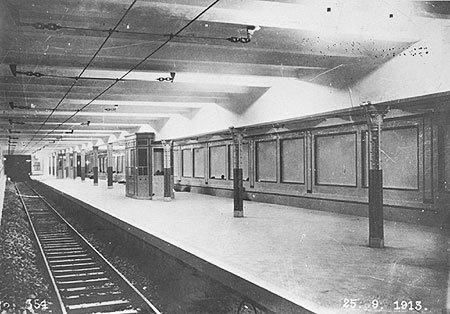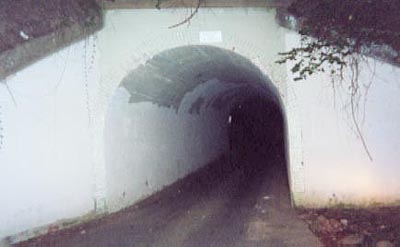|
Alberti Norte (Buenos Aires Underground)
Alberti Norte is a ghost station in the Buenos Aires Underground, which was part of Line A (Buenos Aires Underground), Line A until its closure in 1953. It is one of two ghost stations on the line, the other being Pasco Sur (Buenos Aires Underground), Pasco Sur. History The station was originally opened in 1913, as one of the original Line A stations opened that year. The station was unusual for the network in the sense that it only had one platform, serving only trains heading towards Plaza de Mayo (Buenos Aires Underground), Plaza de Mayo, with the opposite platform located some metres away at Alberti (Buenos Aires Underground), Alberti station. Given its proximity to Pasco (Buenos Aires Underground), Pasco's northern platform (located just 124 metres away), both Alberti Norte and Pasco Sur stations were closed in 1953 in order to improve the line's frequency, since the close proximity of stations in that part of the line meant that trains could never accelerate to full speed ... [...More Info...] [...Related Items...] OR: [Wikipedia] [Google] [Baidu] |
Avenida Rivadavia
Avenida Rivadavia is one of the principal thoroughfares in Buenos Aires, Argentina, extending from San Nicolás, Buenos Aires, downtown Buenos Aires to the western suburb of Merlo, Buenos Aires, Merlo. It is considered the third longest avenue (landscape), avenue in the world after Yonge Street (Toronto) and Western Avenue (Chicago), Western Avenue (Chicago). History Upon the designation of the Viceroyalty of the Río de la Plata by the Spanish Empire in 1776, the "Road of the Kingdom of Heaven" leading into Buenos Aires from the east was designated a ''El Camino Real (other), Camino Real'', a "Royal Road" fit for a Viceroy, and afforded improvements and some security. This Royal Road of the West, by 1782, traveled to Mendoza, Argentina, Mendoza, a city over to the west (roughly along the modern National Route 7 (Argentina), National Highway 7). Dubbed Federation Road by the paramount Governor Juan Manuel de Rosas in 1836, it was renamed in honor of former President Be ... [...More Info...] [...Related Items...] OR: [Wikipedia] [Google] [Baidu] |
Mannequins
A mannequin (sometimes spelled as manikin and also called a dummy, lay figure, or dress form) is a doll, often articulated, used by artists, tailors, dressmakers, window dressers and others, especially to display or fit clothing and show off different fabrics and textiles. Previously, the English term referred to human models and muses (a meaning which it still retains in French and other European languages); the meaning as a dummy dating from the start of World War II. Life-sized mannequins with simulated airways are used in the teaching of first aid, CPR, and advanced airway management skills such as tracheal intubation. During the 1950s, mannequins were used in nuclear tests to help show the effects of nuclear weapons on humans. Also referred to as mannequins are the human figures used in computer simulation to model the behavior of the human body. ''Mannequin'' comes from the French word ', which had acquired the meaning "an artist's jointed model", which in turn cam ... [...More Info...] [...Related Items...] OR: [Wikipedia] [Google] [Baidu] |
Constitución (Line E Buenos Aires Underground)
Constitución is a ghost station in the Buenos Aires Underground, which was part of Line E (Buenos Aires Underground), Line E until its closure in 1966. It is one of two ghost stations on the line, the other being San José vieja (Buenos Aires Underground), San José vieja. This was the original terminus of the line when it ended at Constitución railway station and combined with Line C (Buenos Aires Underground), Line C there. History The station was the original terminus of Line E (Buenos Aires Underground), Line E when it still had its original trajectory to Constitución railway station where it combined with the General Roca Railway. However, the line was re-routed further towards the centre of the city in 1966 in order to improve the line's traffic and the station was closed along with San José vieja (Buenos Aires Underground), San José vieja station on 24 April 1966. [...More Info...] [...Related Items...] OR: [Wikipedia] [Google] [Baidu] |
San José Vieja (Buenos Aires Underground)
San José vieja is a ghost station in the Buenos Aires Underground, which was part of Line E until its closure in 1966. It is one of two ghost stations on the line, the other being Constitución. History The station was part of Line E's original trajectory to Constitución railway station Constitución railway station () is a large railway station in Constitución, Buenos Aires, Constitución, a in central Buenos Aires, Argentina. The full official name of the station is (in English: Constitution Square Station) reflecting the fa ... where it combined with Line C and terminated. However, the line was re-routed further towards the centre of the city in 1966 in order to improve the line's traffic and the station was closed along with Constitución station. In the year the line was re-routed, the station was still used briefly as part of a low-frequency branch of the line. However, when it was finally closed in that same year, it was used as a storage area for the line' ... [...More Info...] [...Related Items...] OR: [Wikipedia] [Google] [Baidu] |
La Brugeoise Cars (Buenos Aires Underground)
''La Brugeoise cars'' were Buenos Aires Underground (''Subte'') Line A (Buenos Aires Underground), Line A rolling stock since its inauguration in 1913 till 2013 when replaced by CITIC-CNR, new Chinese stock. They were built by the Belgian Rolling stock, railway rolling stock manufacturer La Brugeoise et Nivelles between 1911 and 1919 for the Anglo-Argentine Tramways Company's (''Compañía de Tranvías Anglo-Argentina'' (CTAA) in Spanish) first underground line. They were originally designed to run both as Rapid transit, metro and tramway cars, but they were refurbished in 1927 for underground use only. They became the oldest underground rolling stock in commercial service in the world as well as a tourist attraction and part of Buenos Aires cultural heritage. Technical information The La Brugeoise trains were designed to run using either 550 VDC (as surface tramways did until the system was closed in 1962) or 1,100 VDC in the tunnels. Traction was controlled through a 9-p ... [...More Info...] [...Related Items...] OR: [Wikipedia] [Google] [Baidu] |
Urban Myth
Urban legend (sometimes modern legend, urban myth, or simply legend) is a genre of folklore concerning stories about an unusual (usually scary) or humorous event that many people believe to be true but largely are not. These legends can be entertaining but often concern mysterious peril or troubling events, such as disappearances and strange objects or entities. Urban legends may confirm moral standards, reflect prejudices, or be a way to make sense of societal anxieties. In the past, urban legends were most often circulated orally, at gatherings and around the campfire for instance. Now, they can be spread by any media, including newspapers, mobile news apps, e-mail, and most often, social media. Some urban legends have passed through the years/decades with only minor changes, in where the time period takes place. Generic urban legends are often altered to suit regional variations, but the lesson or moral generally remains the same. Origin and structure The term "urban le ... [...More Info...] [...Related Items...] OR: [Wikipedia] [Google] [Baidu] |
Metrovías
Metrovías S.A. is an Argentine privately held company that operates the Metropolitan services of the Urquiza Line. 90% of Metrovías' shares are held by Grupo Roggio. Metrovías was also operator of the Buenos Aires Underground from 1995 to December 2021, when "Emova Movilidad S.A." took over the concession of the service for 12 years. Emova is also part of the Roggio Group and also associated with Metrovías.Subte: a partir de mañana Emova Movilidad S.A. se hará cargo de la operación y mantenimiento on GCBA, 30 Nov 2021 History On 1 January 1994, Metrovías took over the concession, granted by the Argentine government as part of[...More Info...] [...Related Items...] OR: [Wikipedia] [Google] [Baidu] |
Railway Privatisation In Argentina
Railway privatisation in Argentina was a process which began in 1989 under the presidency of Carlos Menem, following a series of neoliberalism, neoliberal economic reforms. This primarily consisted of breaking up the state-owned railway company Ferrocarriles Argentinos (FA) and allowing the former lines to be operated by private companies instead of the state. This policy was met with widespread criticism and proved catastrophic for the Argentine railways whose service worsened significantly in the years that followed, with entire lines closing and infrastructure deteriorating beyond repair. Privatisation was ultimately reversed in 2015 with the creation of Nuevos Ferrocarriles Argentinos. Background Since railway nationalisation in 1948, during the presidency of Juan Perón, the network had been operated by the state-owned company Ferrocarriles Argentinos (FA) which comprised the six relatively independent divisions, Domingo Sarmiento Railway, Sarmiento, General Bartolomé Mi ... [...More Info...] [...Related Items...] OR: [Wikipedia] [Google] [Baidu] |
Pasco (Buenos Aires Underground)
Pasco is a station on Line A of the Buenos Aires Underground. The station belonged to the inaugural section of the Buenos Aires Underground opened on 1 December 1913, which linked the stations Plaza Miserere and Plaza de Mayo. Like the Alberti station, it only has one platform, which in this case only serves passengers traveling to Plaza de Mayo. The other platform (the ghost station A ghost station is a closed or never opened train station through which revenue-service passenger trains (especially rapid transit trains) pass but at which they do not stop. The term is also sometimes used for any unused underground station o ... Pasco Sur) is located just a few meters away, but was closed in 1953 since the proximity of Alberti station meant having so many stops in such quick succession slowed the line's frequency. [...More Info...] [...Related Items...] OR: [Wikipedia] [Google] [Baidu] |
Side Platforms
A side platform (also known as a marginal platform or a single-face platform) is a railway platform, platform positioned to the side of one or more railway tracks or guideways at a railway station, tram stop, or bus rapid transit, transitway. A station having dual side platforms, one for each direction of travel, is the basic design used for double-track railway lines (as opposed to, for instance, the island platform where a single platform lies between the tracks). Side platforms may result in a wider overall footprint for the station compared with an island platform, where a single width of platform can be shared by riders using either track. In some stations, the two side platforms are connected by a footbridge or Subway (crossing), tunnel to allow safe access to the alternate platform. While a pair of side platforms is often provided on a dual-track line, a single side platform is usually sufficient (trains are usually only boarded from one side) for a single-track line. Layou ... [...More Info...] [...Related Items...] OR: [Wikipedia] [Google] [Baidu] |
Alberti Norte
Alberti may refer to: Leon Battista Alberti, the Renaissance architect Places * Alberti Partido, a partido of Buenos Aires Province, Argentina * Alberti, Buenos Aires, the main town of the partido * Alberti (Buenos Aires Underground), a railway station Other uses * Alberti (surname) * Alberti bass, a musical accompaniment figuration, usually in the left hand on a keyboard instrument * Alberti cipher, an early polyalphabetic cipher (late 15th century) * Alberti (family), Florentine political family See also * Albertis (other) * Albertoni Albertoni is a surname. Notable people with this surname include: * Gaspare Paluzzi degli Albertoni (1566–1614), Roman Catholic Bishop of Sant'Angelo dei Lombardi e Bisaccia * Gianne Albertoni (born 1981), Brazilian actress and model * Ludovica ..., a surname * D'Albertis (other) {{disambiguation, geo ... [...More Info...] [...Related Items...] OR: [Wikipedia] [Google] [Baidu] |






